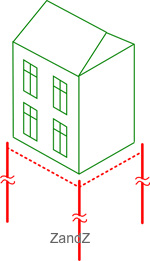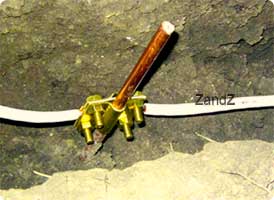Lightning protection is a set of components designed to ensure the safety of buildings and people in case of a direct lightning strike into a house by its interception and the discharge of lightning currents into the soil through the grounding system.
Lightning protection rod
Lightning protection rod (lightning rod, lightning discharger) serves for receiving a lightning strike and is located in the area of possible contact with the lightning channel. Depending on the facility to be protected the lightning protection rod can be of the following types:
- Metal rod
- A meshed cage made of a conductive material
- A metal catenary wire stretched over the house to be protected
About lightning: clearly and in detail
This video will tell you about the origin of lightning and the role of lightning protection and grounding in the safety of people and houses
Grounding quality requirements
The resistance of grounding used to connect the lightning protection rods should be as follows:
-
in ordinary clay soils
maximum 10 Ohm (RD 34.21.122-87, p. 8) -
in sandy soils maximum 40 Ohm
(RD 34.21.122-87, p 8;. for soils with the specific electrical resistance of over 500 Ohm * m)
The ground should be composed of at least 3 vertical electrodes spaced apart by a distance equal to at least two electrode immersion depths (RD 34.21.122-87, para. 2.2.g).
Furthermore, ground electrodes and a grouning conductor between the electrodes shall be distanced
at least 1 meter from the building wall (SО 153-34.21.122-2003, p. 3.2.3.2).
Lightning protection grounding kit

Modern technologies allow you to quickly and easily build an effective grounding, which will serve for a very long time without the need for maintenance and repair.
To build a lightning protection grounding of the required quality (grounding resistance), it is recommended to use ZZ-000-015 universal grounding kit installed
as three electrodes spaced apart 5 to 10 meters from each other.
Customized kits
Using off-the-shelf grounding kits is just a basic recommendation. In each individual case, it is possible to compose your customized kit comprising individual components in the required quantities.
Connecting electrodes to each other
The connection is made in the soil by a steel tape 5*30 or 5* 40mm.
The conductor is laidat a depth of 0.5 - 0.7 meters into a prepared trench (where electrodes are also installed).
To connect the ground electrode to the conductor a special clamp is used (included in the kit).
A detailed description of all mounting steps is available at a separate "Installation of Grounding" page.
Connecting grounding to an electric board
The connection is made by a copper conductorwith a recommended section of 16 - 25 mm². For example, a special grounding conductor can be used.
Related Articles:




